Fortified Churches of Transylvania
Once upon a time, a Hungarian king called Geza II (1141-1162), had a problem. His kingdom needed defending, especially in the south and east, in what is now Romania. It was the Middle Ages, and everybody was fighting over territory. So starting in the 12th century, he sent ethnic Germans to settle in Transylvania, and they continued to move there until the end of the 13th century. These colonists became known as Saxons.
Disclosure: This article contains affiliate links. If you click on one and make a purchase, I will receive a small commission. This will not affect your price.
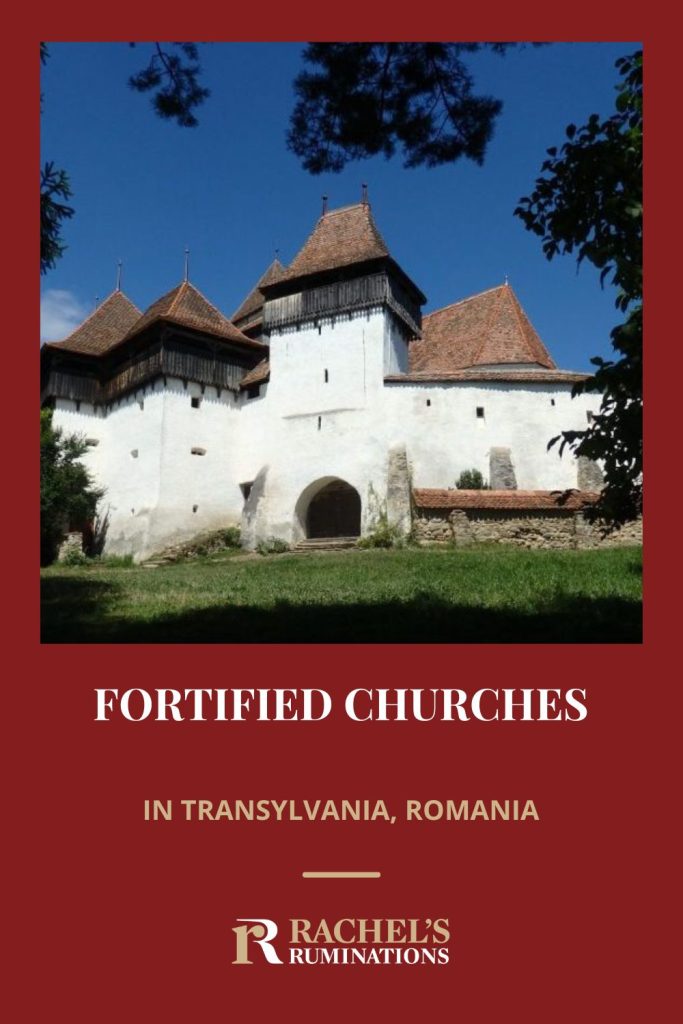
In order to defend themselves against attack, especially from the Ottomans and the Tatars, the Transylvanian Saxons built fortifications. In some cases the fortification centered around a castle or even an entire town, but in many smaller villages, they instead added defenses to their churches.
The resulting structures – about 150 of them remain – are today called fortified churches, and they are scattered across many Transylvanian villages. Seven of them together make up a UNESCO World Heritage site.
I’ve posted before about Dracula’s castle, a popular tourist destination. But when my husband and I took our road trip to Romania, we were much more interested in visiting the seven fortified churches in the UNESCO designation. There are far more things to do in Transylvania, of course, but these were the highlight for us.
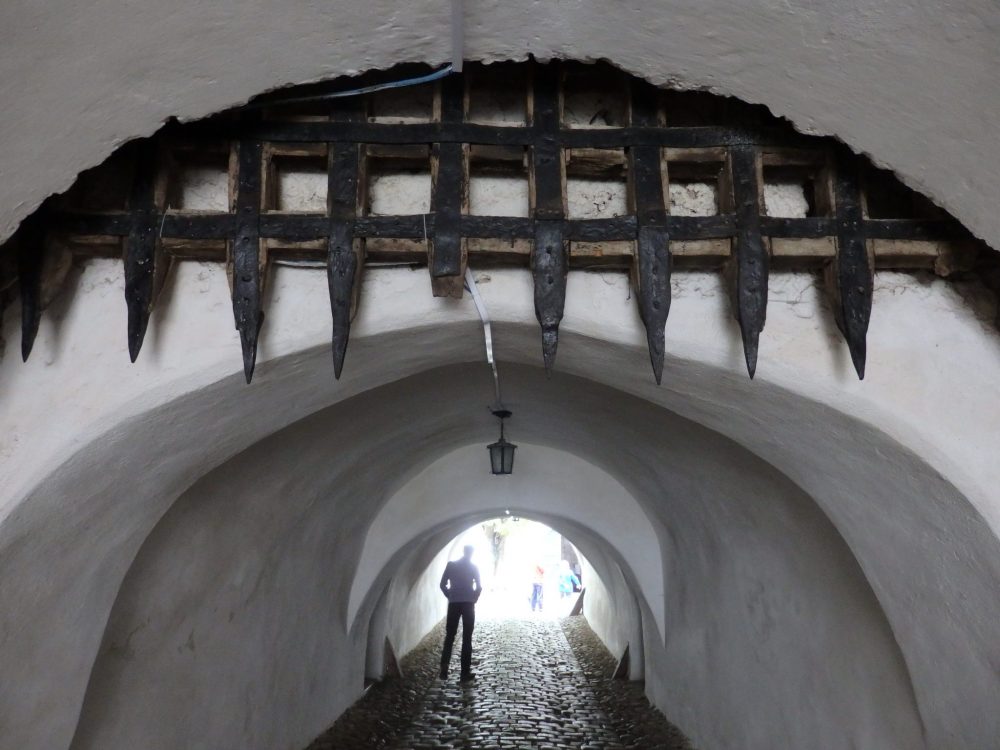
Câlnic
This was the first fortified church we visited, yet it was more like a castle than a fortified church. It has a traditional keep in the center, built in the late 13th century, and fortification walls and gates built of stone.
When we arrived, it was closed, but a sign on the gate gave a phone number. When I called, I was told that someone would be there in ten minutes. Waiting, we watched village life pass by in the form of a man driving a horse and cart, and a group of children stared at us and asked for money before they wandered away again. Soon, a woman on a bike arrived and let us in.
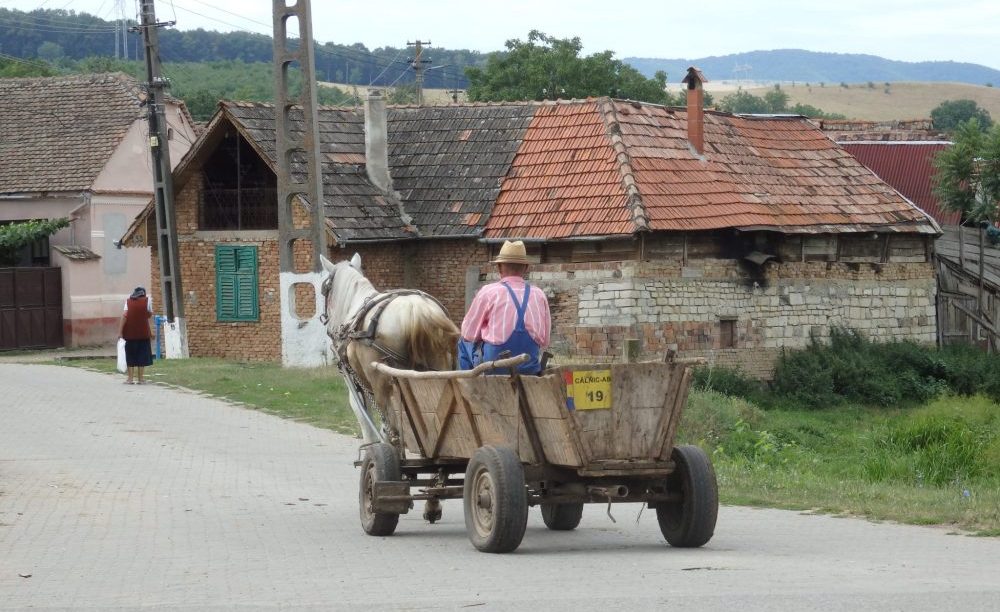
When the noble family that owned Câlnic castle left in 1430, they sold it to the local community, which converted it into a more traditional Saxon village fortification. They added the church (or replaced an older one) in the 15th century and made other changes to increase its defensibility.
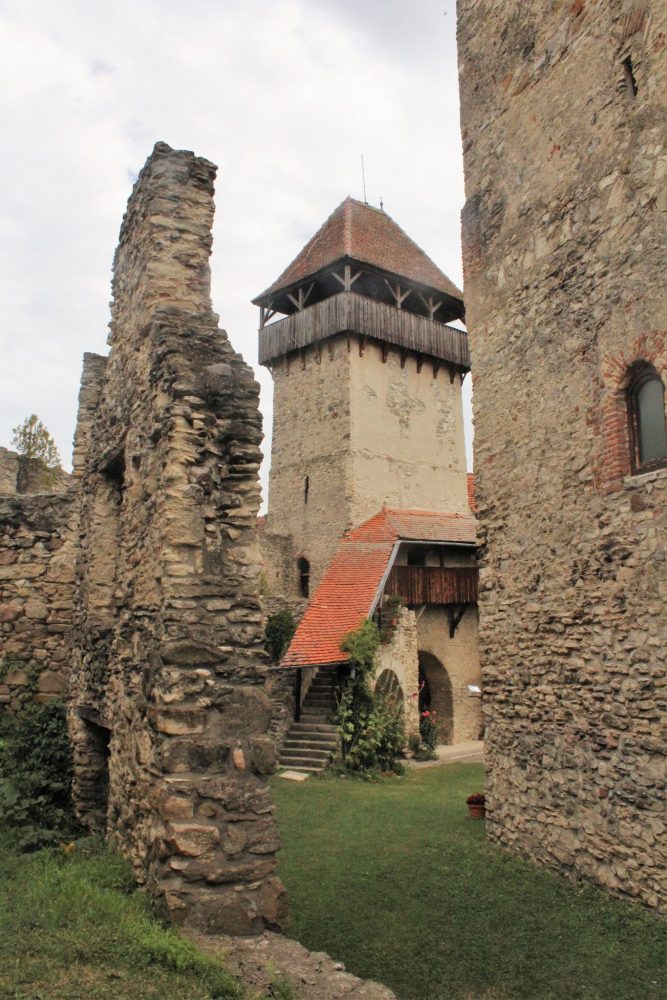
Today it is a lovely space, sometimes used for events. The church is painted inside in the traditional Transylvanian flowery style. In the keep, the village has established a small museum, with a hodgepodge of articles meant to illustrate aspects of local village life.
Calnic is a two-hour drive WSW of Sighisoara or 40 minutes NW of Sibiu. Open summers daily 9:00-19:00 and winters daily 10:00-17:00. Admission 5 lei; camera fee 7 lei.
Prejmer
Prejmer was a favorite for us, and it takes a longer visit than the others because there is so much to explore.
The Order of the Teutonic Knights started to build the church in 1218, but the Cistercian monks finished it after the Teutonic Knights were expelled in 1225. It was fortified starting in the 15th century.
After entering through an arched passage, complete with portcullis, we emerged into a charming interior courtyard, edged with a four-story structure lining the fortification’s outer walls. The structure is dotted with doorways and windows and laced with stairways and external corridors in dark wood. The more than 270 rooms could be used for shelter or as storage rooms in case of attack or if there was a long siege. The church, a classically Gothic style, is protected inside these walls.
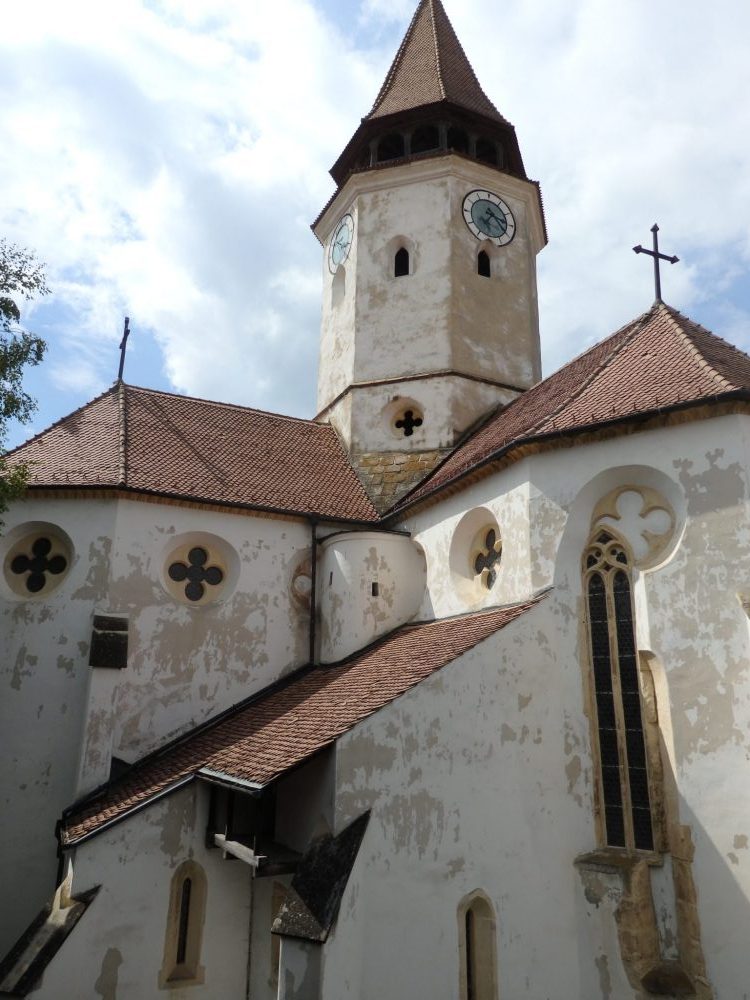
We were allowed to climb the stairs and peer into many of the rooms, a few of which have furnishings or items on display. We could also walk the defensive space above the rooms, just under the roof: a tunnel of sorts all the way around the inside of the wall, which would have allowed soldiers to shoot through openings down toward anyone who dared attack.
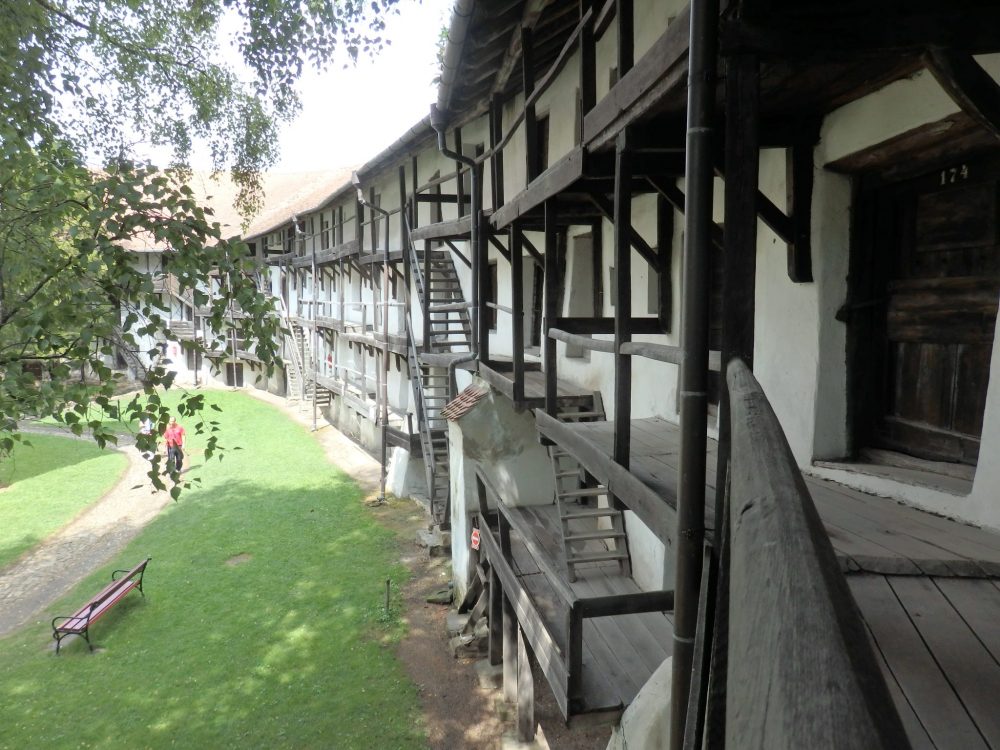
The fortified church of Prejmer is located about 25 minutes NE of Brasov and two hours SE of Sighisoara. Open April-Oct. Mon.-Sat. 9:00-18:00 and Sun. 11-18:00. Open Nov.-March Mon.-Sat. 9:00-16:00 and Sunday 11:00-16:00. Admission 15 lei.
Biertan
The Fortified Church of Biertan is in one of the prettier Saxon villages, with houses huddled up against the outer defensive wall. The church inside dates from the 15th century, so its style is late Gothic, with some decorations that are more Renaissance style.
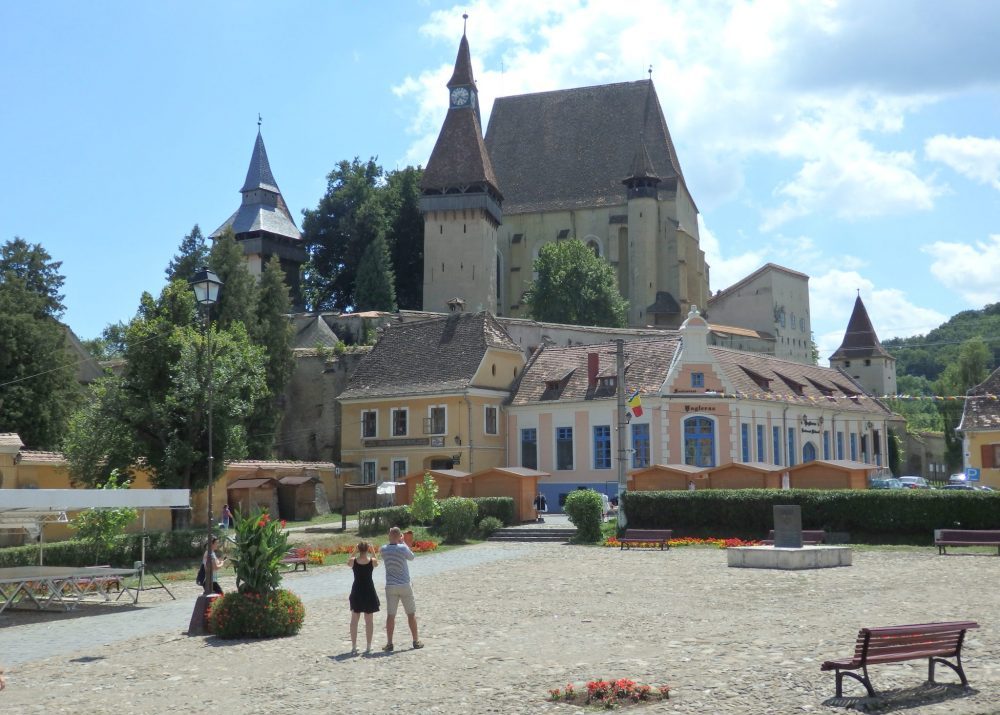
Biertan’s church has fortifications of its own, which you can see clearly on the church tower: it doubled as a steeple and a defense tower or watchtower. The church sits on a hill above the village, allowing defenders to see approaching enemies from a distance.
Not long after the church was built, the concentric walls were added, along with several tall defensive towers.
Biertan Fortified Church is a half-hour’s drive west of Sighisoara. Open Tuesday-Sunday 10:00-13:00 and 14:00-19:00. Admission 10 lei.
Darjiu
The fortified church at Darjiu is Unitarian, unlike most of the others, which are Lutheran. This is because it’s the only one in the UNESCO collection that didn’t protect a Saxon village. The people here were Székely: Hungarians.
The simple church dates to the 13th century and the decorations inside are particularly flowery. I liked the medieval frescoes too, which illustrate the legend of Ladislaus I, who, in the 11th century, fought the Cumans (a Turkic group) to free a noble’s daughter. He was later made a saint. The Facebook Live video below gives you a better view than any of the still pictures I took:
I suspect that Darjiu was a smaller or poorer village. The defensive walls around the church are quite low, and the towers don’t loom nearly as high as at some of the others.
Visitors can climb the church tower here too, and get a good view of the surrounding country.
Read these articles about other UNESCO World Heritage sites – also groups of churches – in Romania:
Darjiu is 45 minutes east of Sighisoara. In April, May, June, September and October, open by appointment only between 10:00 and 18:00 Tuesday-Sunday. Call +40 744 557 659 for an appointment or email . In July and August, open Tuesday-Sunday 10:00-18:00. Closed November-March.
Saschiz
The main defensive structure at the Saschiz fortified church is the rather ornate bell tower dating to about 1500. It’s seven stories tall now, but was originally only five. Like the towers of many of the fortified churches, it served both as a belltower and a guard post. It even has arrow loops to shoot through.
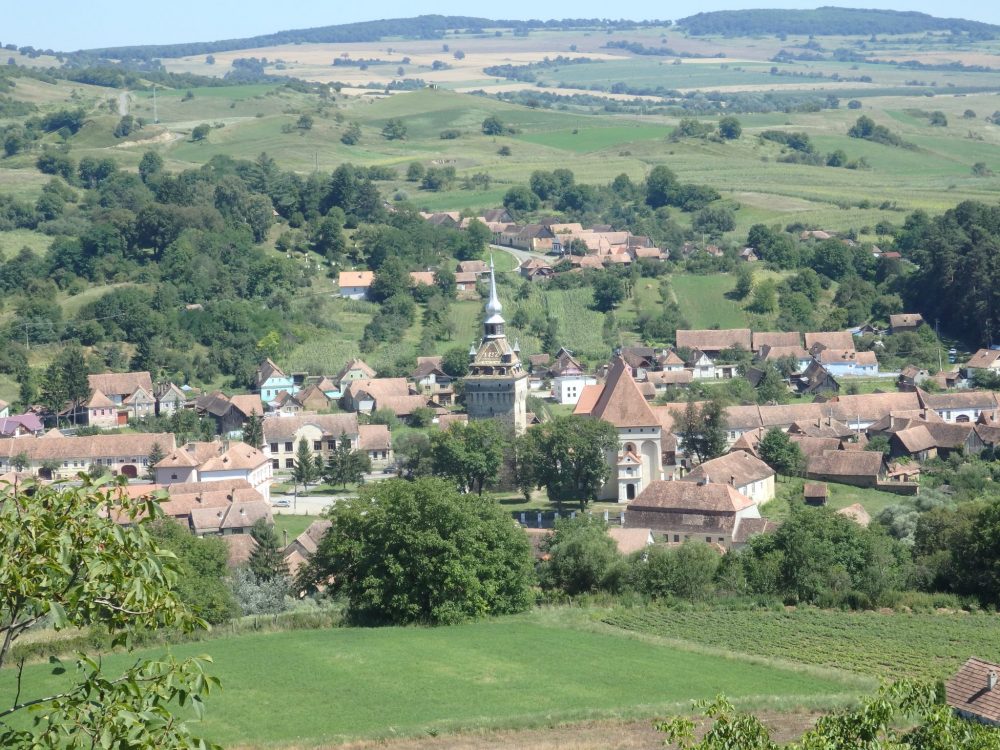
It’s not clear whether Saschiz ever had defensive walls, or if the tower was considered enough. The church next to the tower is Gothic, but less elaborately decorated than some of the others.
Perhaps the reason it needed less defending was the medieval castle that used to top the hill above the village. Today the ruins are not maintained in any way, but an informal footpath leads up there. Completely overgrown, you can spot where the keep used to be – now just a small, overgrown rise – inside the ruined walls with guard towers partially still standing. I recorded the Facebook Live video below at this castle. Please pardon the quality; Facebook Live does not lend itself to editing.
Saschiz is a 20-minute drive east of Sighisoara. Open Wednesday-Monday 10:00-18:00.
Valea Viilor
Like Darjiu, Valea Viilor doesn’t have very high walls: in this case a series of arches with rooms and an external walkway one flight up. Like Saschiz, it looks like the church tower itself was Valea Viilor’s primary defensive structure.
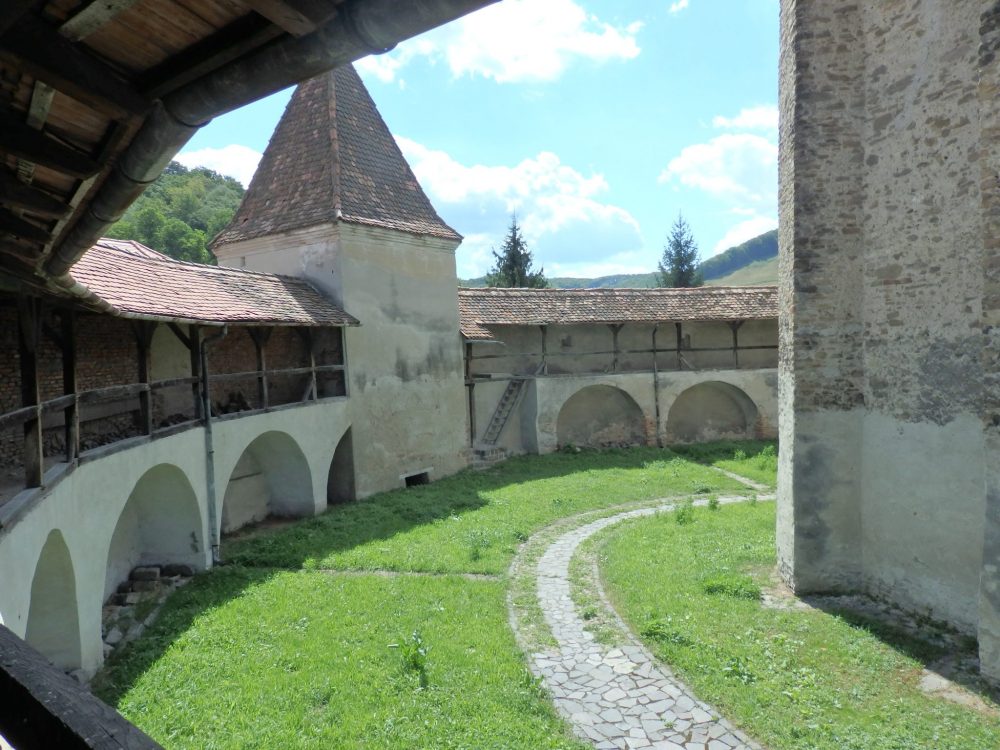
We climbed the church tower: a scary thing for me to do, given my fear of heights. From the top, we could survey the surrounding village and the hills beyond it, as well as peer down – to the extent that I dared – at the walls below. From that angle, they don’t look like they’d be very effective in an attack.
The church inside is not highly decorated, but has the typical Gothic traits of all of these fortified churches.
Valea Viilor is about an hour west of Sighisoara. Open summers daily 9:00-12:00 and 14:00-17:00. Winters only by appointment. Call +40 269 515 266. Admission 5 lei.
Viscri
To get to Viscri involves driving through a village on an unpaved, partially cobbled road. The church is a particularly photogenic one, perched on a small hill. Its whitewashed walls topped with towers give the impression of a small medieval castle.

The church inside boasts rather primitive paintings covering the woodwork of the side and upper galleries. Some of it was clearly intended as trompe l’oeil marble, but isn’t very successful. The result is somehow charming.
Again the Saxon settlers here didn’t build very high walls, but they chose their site well: the fortifications circle the top of a hill. They afford a bigger view than their size would suggest. At the top of the church’s squat, square, fortified tower, we could see far across the village to the rolling hills and farmland beyond.
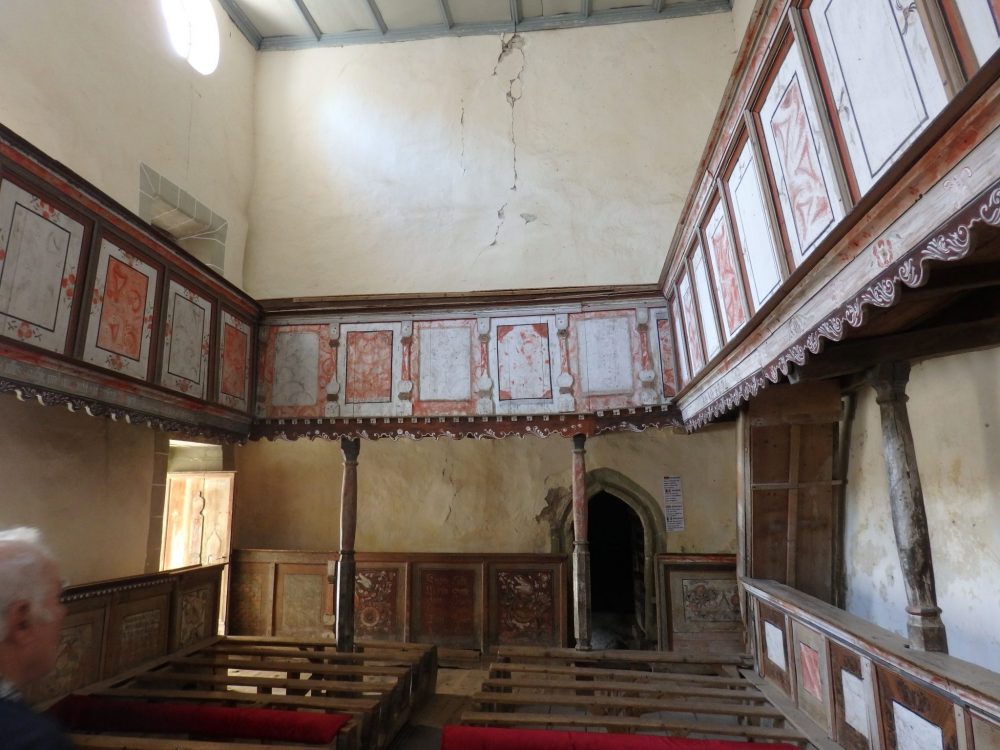
Viscri also includes a museum, again displaying odds and ends of daily life in rural Saxon Romania: traditional clothing, furniture, embroidery, ceramics, and so forth.
This, by the way, was the only one of the fortified churches where we saw souvenir stalls set up in the village outside.
Viscri is 45 minutes SE of Sighisoara. Open daily 10:00-13:00 and 15:00-18:00. Admission 5 lei.
Bunesti
We didn’t actually plan to visit Bunesti; we just happened upon it. It’s not part of the UNESCO World Heritage group of churches, but it is one of an additional group of about 15 that are supported by European Union funds.
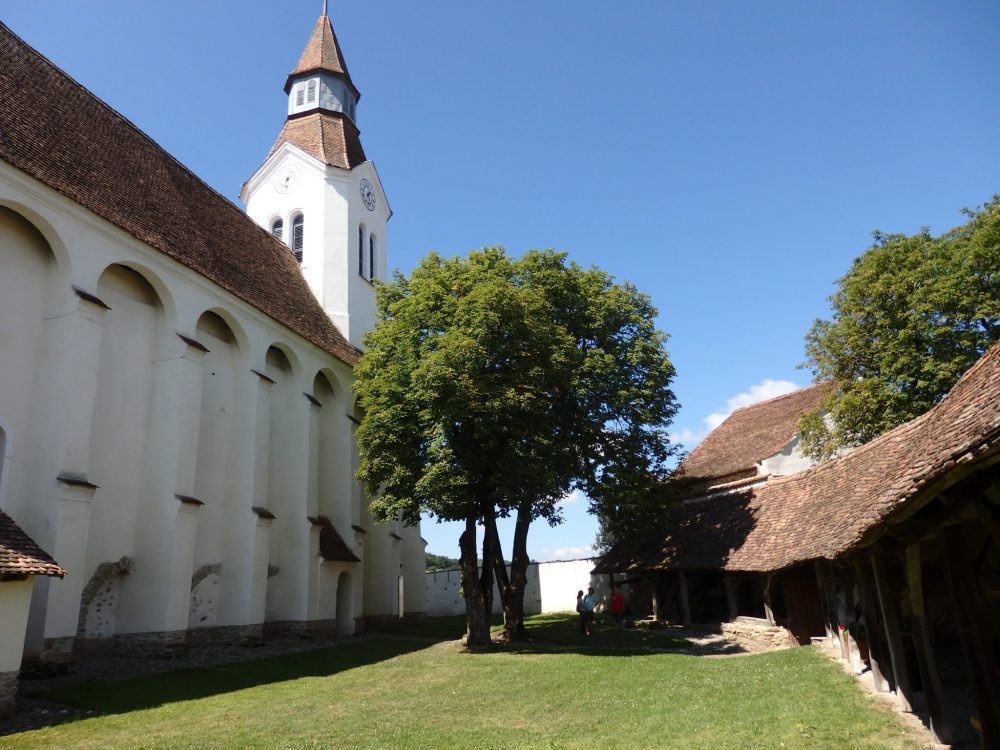
Yet Bunesti was just as interesting as the UNESCO ones. Its church (late 13th century Romanesque) has an ornate carved altar. It’s quite tall inside, and the end opposite the altar holds two stories of balconies, intricately painted in an only slightly less primitive style than the paintings at the smaller church in Viscri. It was fortified later, in about 1500.
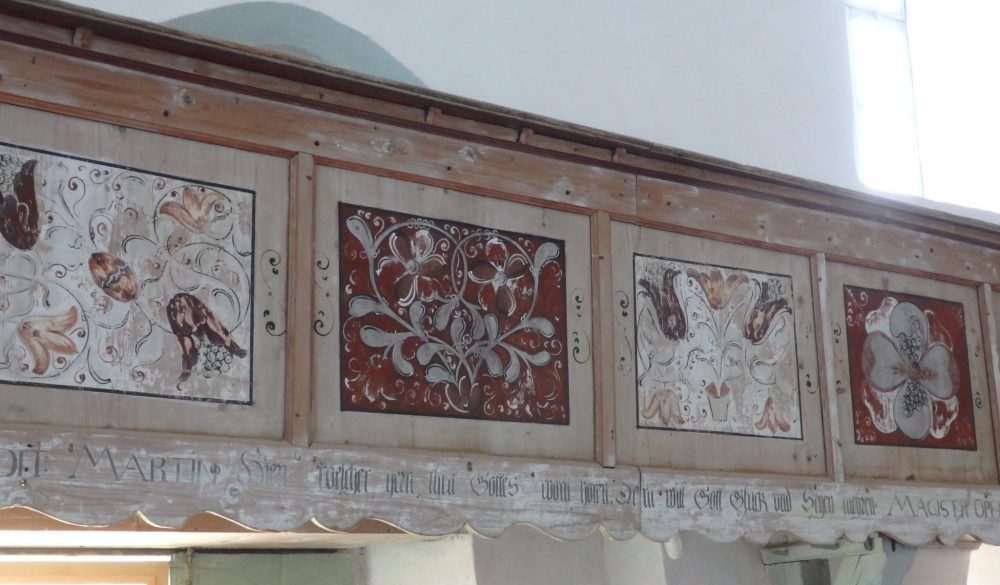
The walls around the church date to the 14th century, and have rooms along the inside for storage. Again, they are quite low. And again, we could climb the tower of the church to see the view. In this case the church isn’t on much of a hill, yet the view from the top would still allow for plenty of warning.
Bunesti is about a half hour SE of Sighisoara, on the route between Saschiz and Viscri.
Târnave
We stopped at two more fortified churches just because we happened to pass them. One was in very bad condition. The walls were propped up with wooden beams, and the gate was locked up.
The other was the fortified church in Târnave. The church is simple inside, with less decoration than the others we saw.
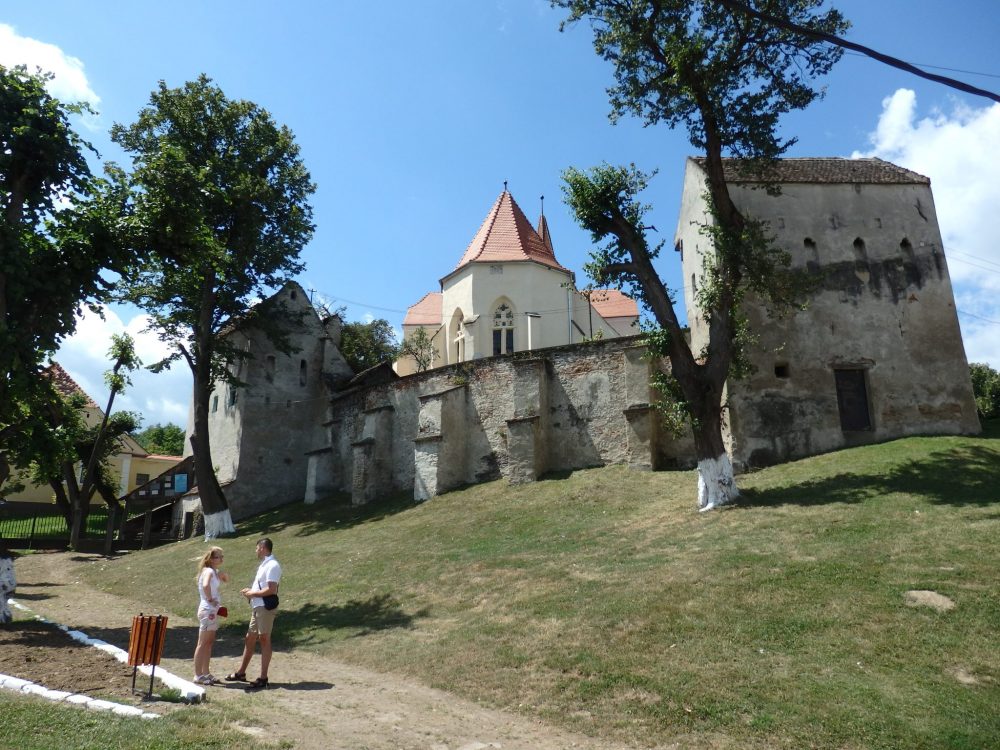
The tower of the church is simple and strong, without the open guard area at the top: only a few windows. The walls around the church are also simpler than the other fortified churches we visited: just walls with occasional square guard towers, but without a space to walk around the walls, and without storage areas.
Tarnave is 20 minutes west of Sighisoara, on the way to Biertan and Valea Viilor.
Recommendations
We loved visiting all of these, and we did it in two days, without feeling rushed. That’s because each one, except perhaps Prejmer, will only take about a half hour to an hour of your time, depending on whether you climb all available towers and spend time in museums. (The small museums that many of these churches have are all very similar, so we stopped doing more than strolling quickly through them.) An added bonus is that there were very few other tourists at any of them, even though we visited at the end of July. What took us the most time was driving between them.
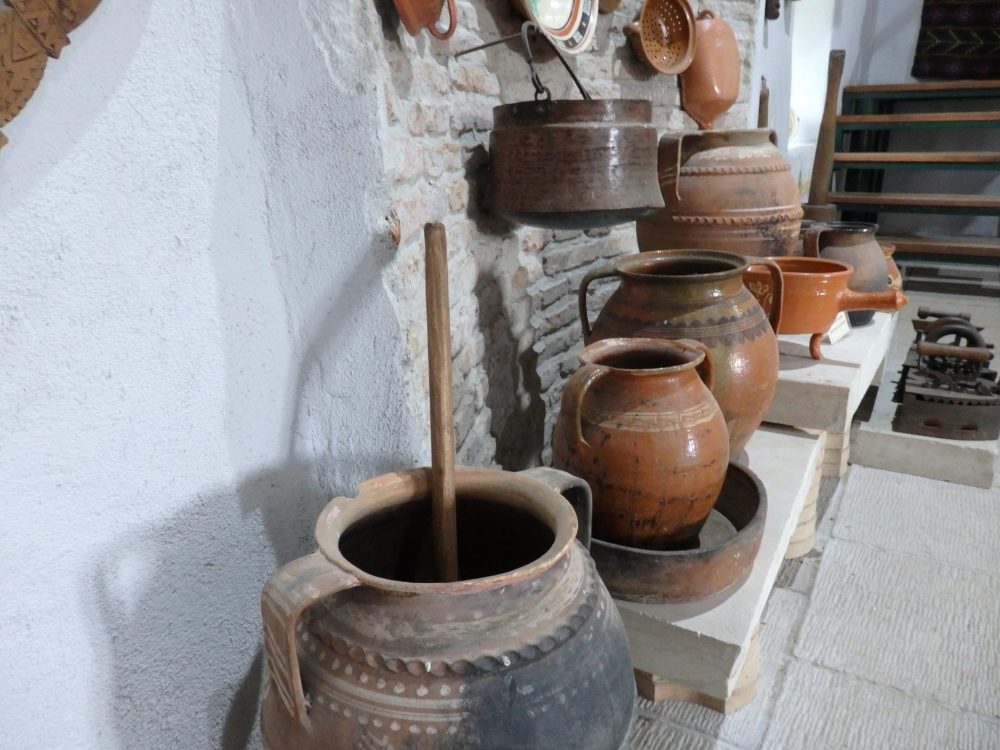
If you don’t feel the need to visit them all, I’d suggest Prejmer first of all, and Viscri in second place.
Details: Go to the UNESCO list for the details on the fortified churches. You can also read more about some of the fortified churches on Romania Tourism’s website.
The only practical way to visit the fortified churches is by car. If you can’t drive to Romania like we did, the most convenient is to pick up a car at the airport on arrival.
As you can see from the map below, where I’ve marked all of the above churches, most are in Sibiu county or nearby. Probably the best place to stay is Sighisoara, a beautiful town in its own right. Book accommodations in Sighisoara.
<center><iframe src="https://www.google.com/maps/d/u/0/embed?mid=1wwMmigT2Lv7cvVejz0JdUWUYCNOdZI4&ehbc=2E312F" width="640" height="480"></iframe></center>Without a car, it will be nearly impossible to see more than one or two of the fortified churches. A few tours leaving from Brasov include Prejmer, some of which also include one we didn’t visit called Harmon. This tour about the Saxons visits Biertan and Viscri. This biking tour includes Viscri and Bunesti, but you’ll have to get to Bunesti for the start of the tour. There are several other options that bundle Viscri in with places like Sighisoara and Bran Castle.
My travel recommendations
Planning travel
- Skyscanner is where I always start my flight searches.
- Booking.com is the company I use most for finding accommodations. If you prefer, Expedia offers more or less the same.
- Discover Cars offers an easy way to compare prices from all of the major car-rental companies in one place.
- Use Viator or GetYourGuide to find walking tours, day tours, airport pickups, city cards, tickets and whatever else you need at your destination.
- Bookmundi is great when you’re looking for a longer tour of a few days to a few weeks, private or with a group, pretty much anywhere in the world. Lots of different tour companies list their tours here, so you can comparison shop.
- GetTransfer is the place to book your airport-to-hotel transfers (and vice-versa). It’s so reassuring to have this all set up and paid for ahead of time, rather than having to make decisions after a long, tiring flight!
- Buy a GoCity Pass when you’re planning to do a lot of sightseeing on a city trip. It can save you a lot on admissions to museums and other attractions in big cities like New York and Amsterdam.
- Ferryhopper is a convenient way to book ferries ahead of time. They cover ferry bookings in 33 different countries at last count.
Other travel-related items
- It’s really awkward to have to rely on WIFI when you travel overseas. I’ve tried several e-sim cards, and GigSky’s e-sim was the one that was easiest to activate and use. You buy it through their app and activate it when you need it. Use the code RACHEL10 to get a 10% discount!
- Another option I just recently tried for the first time is a portable wifi modem by WifiCandy. It supports up to 8 devices and you just carry it along in your pocket or bag! If you’re traveling with a family or group, it might end up cheaper to use than an e-sim. Use the code RACHELSRUMINATIONS for a 10% discount.
- I’m a fan of SCOTTeVEST’s jackets and vests because when I wear one, I don’t have to carry a handbag. I feel like all my stuff is safer when I travel because it’s in inside pockets close to my body.
- I use ExpressVPN on my phone and laptop when I travel. It keeps me safe from hackers when I use public or hotel wifi.



Your article is so interesting. I would love to follow in your footsteps; my kind of adventure!!
Thx so much for this fabulous post on the fortified churches of Transylvania, Rachel. I would definitely enjoy exploring Romania.
We’re hoping to spend some time in Romania in 2018 and visiting the fortified churches has just been added to my “Must See” list when we get there. The history lesson of the Saxons, Ottomans and Tatars was fascinating and your photos are beautiful. I get the feeling that, despite this group of churches being UNESCO sites, they garner little attention compared to their competition which is a shame. Thanks for introducing me to the fortified churches! Anita
We had them pretty much to ourselves. We also visited two other church collections in Romania (painted churches in Moldavia and wooden churches in Maramures) that are UNESCO listed and pretty much ignored! Bear in mind that these areas don’t have highways, so travel in the northern half of Romania can be quite slow.
Super pictures. I loved looking at your pictures. I felt I was in Transylvania. Great story too.
Thank you!
I guess I can understand why churches might need to be fortified (then and now). I do like the interior floral decoration. I do not think I would have recognised several of the churches in your photos as churches.
I know right? They look like little castles!
Love a good history lesson and even better to walk through history as you’ve done. I can’t believe how much you did in two days. I loved this region. The Saxon influence gives it such a charming appeal.
It’s amazing how much sightseeing you can do when you travel without kids! (This was our first trip longer than a few days that we’ve taken together, without kids, in 27 years!)
These places are wonderful! I have heard about the church in Viscri but not the other ones. You really surprised me by introducing me to those. During my visit to Hungary, I heard about Transylvania a lot (since it was part of Hungary). I would love to visit the area and explore several towns. #TPThursday
Go for it! These churches are all different and interesting, and the countryside in the northern half of Romania is beautiful!
It’s interesting that churches were used as fortresses because I normally assume that they were sanctuaries that invaders were loathe to attack. (Not quite sure where I got that idea. The movies?) I think that I’d like exploring these places and seeing the towns near them. I also didn’t know that Saxons were from what is now Transylvania.
No, the Saxons were Germans, and, if I got the history right, they were sent by the King of Hungary to settle in Romania. They built churches, then built the fortifications around them and/or made their towers defensible.
You’ve certainly made it easy for someone to follow in your footsteps and visit the fortified churches of Transylvania, although that first gate is more than a little intimidating! I especially liked the painted walls of Bunesti. I like off the beaten path destinations and this certainly looks like a charming area of Romania.
Funny, isn’t it, that a UNESCO-listed site could also be “off-the-beaten-path.”
Great article with lots of information and beautiful pictures!
Thank you!
Romania sounds like a great place.I’ve not heard of such a thing as fortified churches before Rachel!
I’ve been gathering info for a database I’ve created about the fortified churches of Romania.
You’ll find info on the restoration of the murals at Dârjiu https://eeagrants.org/archive/2009-2014/projects/RO12-0034
The church was originally Roman Catholic. Abandoned chuches were taken over by Unitarians. There are 75,000 Unitarians in Transylvania, the world’s largest group. One source said that the murals needed to be restored because the Unitarians had whitewash them. I assume that this was done in keeping with the Unitarians preference for simplicity in liturgy and decoration. Today, recognizing historical and artistic value, the Evangelical Church of Romania and the Unitarian Church of Transylvania are cooperating in restoration works.
I’m so glad to hear that the murals at Darjiu have been restored! And also to find out that they’ve printed maps of the whole collection of churches. It’ll make it much easier to visit them all. Thanks for the update!
My previous note was a second attempt. I lost some of the info I originally was sending to you. This site has 360° panoramas of Székerland ( https://virtualisszekelyfold.ro/home_en.php ) including is a page of churches ( https://virtualisszekelyfold.ro/explore_en.php ). Many are fortified.
“…It’ll make it much easier to visit them all.” That’s my goal. However I’ve only been to 4. ( https://pbase.com/larpman/biertan and https://pbase.com/larpman/favorite_day ) The fortified churches have become a major interest of mine. The map you mentioned does not have all of the fortified churches. Wikipedia lists 148, but states, “This list is incomplete; you can help by expanding it.” I have found others and will add them to Wikipedia.
Thank you for this. That 360 panorama site has a good one of Darjiu! And your own photos are lovely! Yes, there are probably many more, but the UNESCO ones are in good shape and open to the public so they’re the ones a casual tourist is most likely to visit.